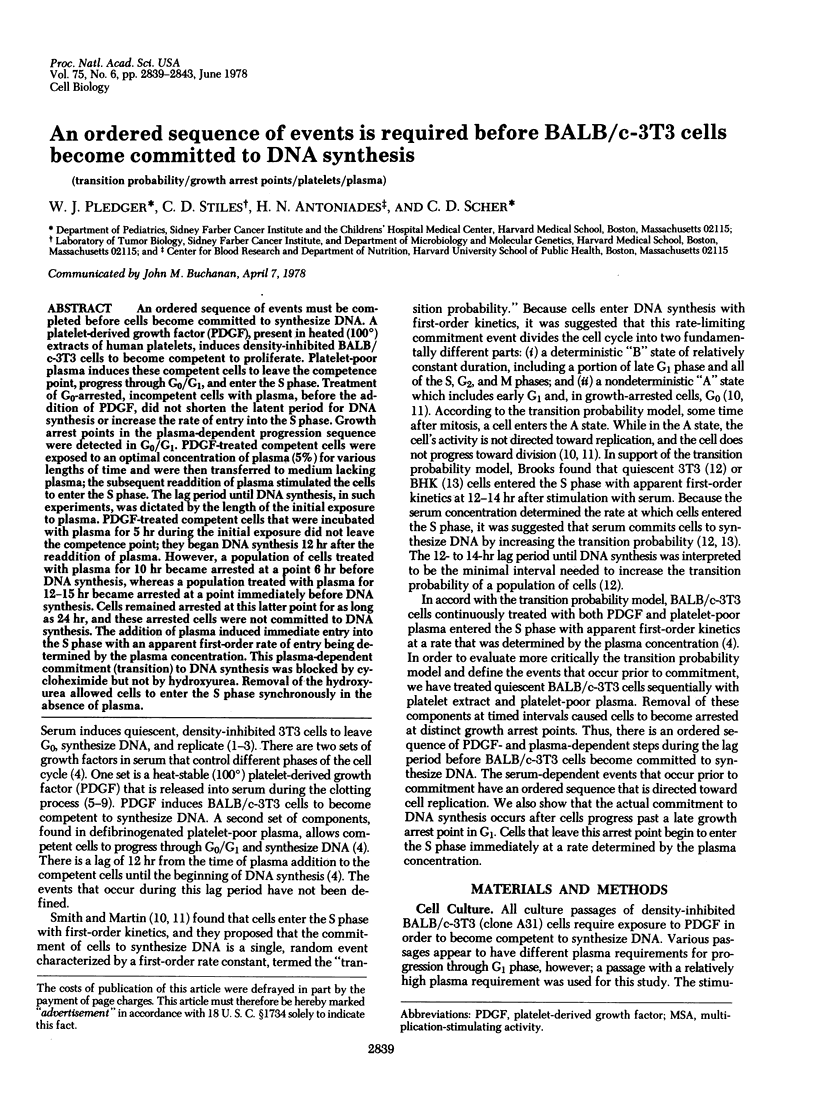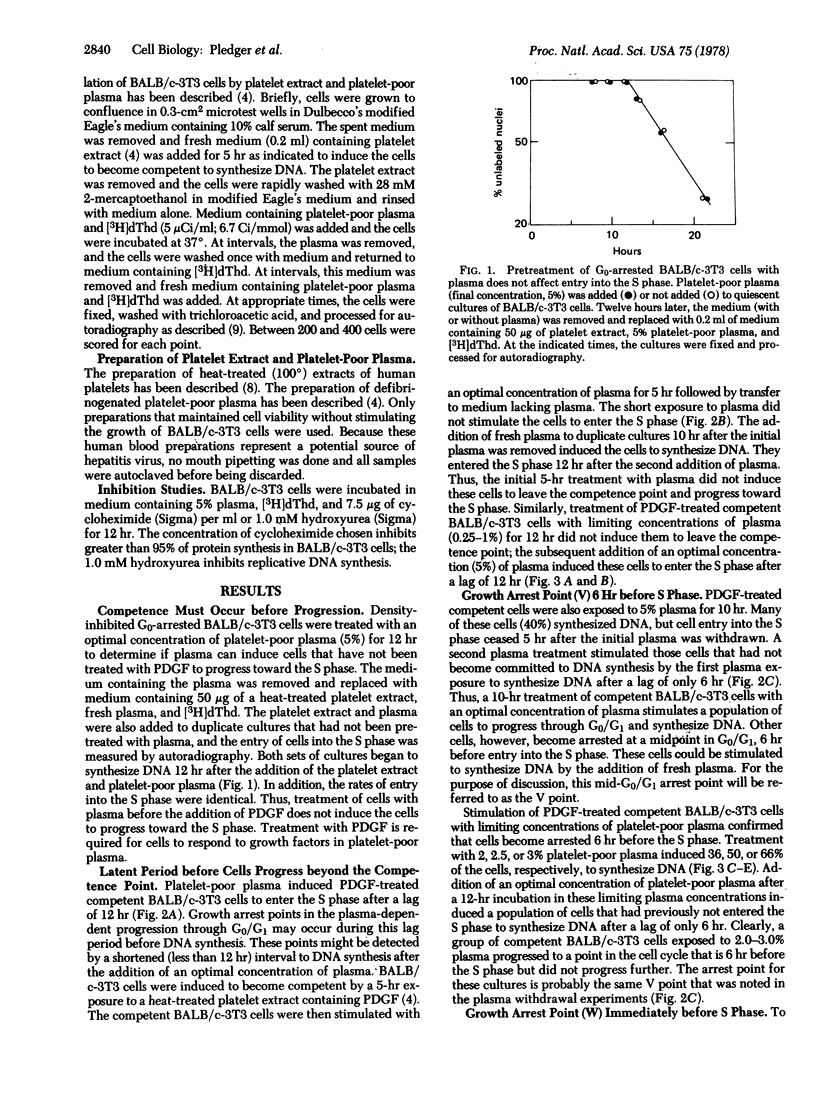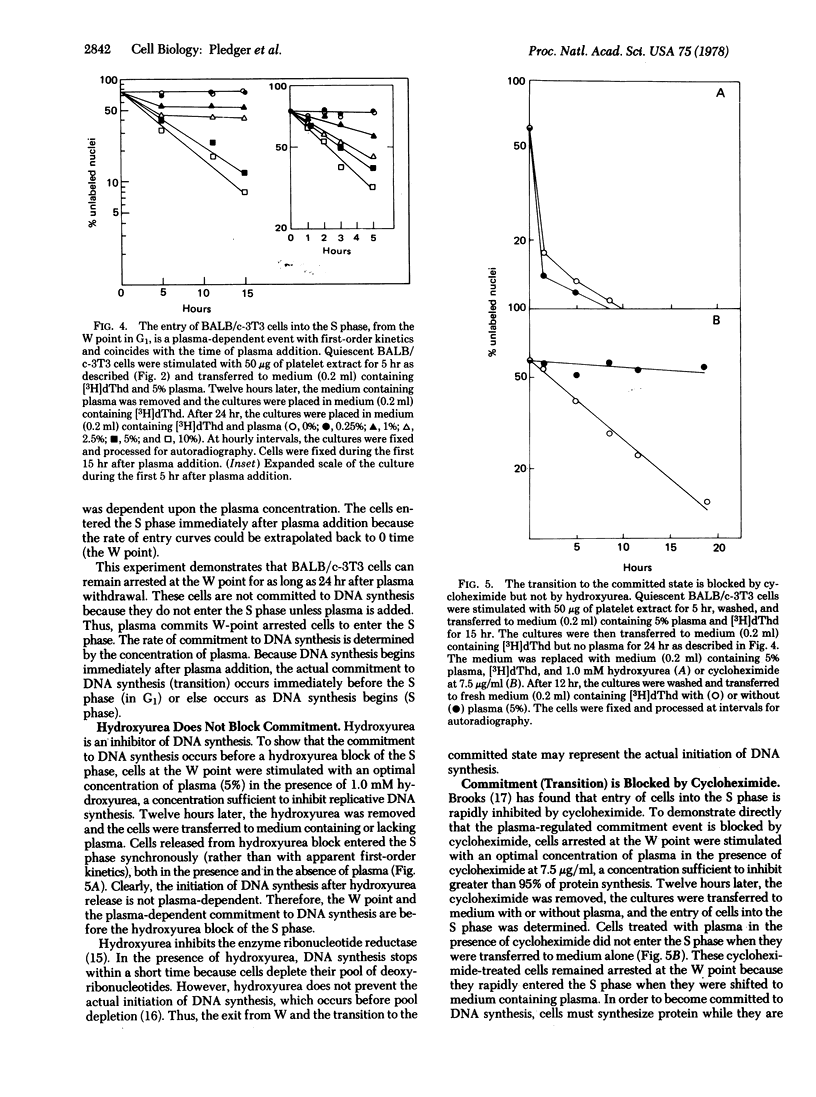Abstract
An ordered sequence of events must be completed before cells become committed to synthesize DNA. A platelet-derived growth factor (PDGF), present in heated (100°) extracts of human platelets, induces density-inhibited BALB/c-3T3 cells to become competent to proliferate. Platelet-poor plasma induces these competent cells to leave the competence point, progress through G0/G1, and enter the S phase. Treatment of G0-arrested, incompetent cells with plasma, before the addition of PDGF, did not shorten the latent period for DNA synthesis or increase the rate of entry into the S phase. Growth arrest points in the plasma-dependent progression sequence were detected in G0/G1. PDGF-treated competent cells were exposed to an optimal concentration of plasma (5%) for various lengths of time and were then transferred to medium lacking plasma; the subsequent readdition of plasma stimulated the cells to enter the S phase. The lag period until DNA synthesis, in such experiments, was dictated by the length of the initial exposure to plasma. PDGF-treated competent cells that were incubated with plasma for 5 hr during the initial exposure did not leave the competence point; they began DNA synthesis 12 hr after the readdition of plasma. However, a population of cells treated with plasma for 10 hr became arrested at a point 6 hr before DNA synthesis, whereas a population treated with plasma for 12-15 hr became arrested at a point immediately before DNA synthesis. Cells remained arrested at this latter point for as long as 24 hr, and these arrested cells were not committed to DNA synthesis. The addition of plasma induced immediate entry into the S phase with an apparent first-order rate of entry being determined by the plasma concentration. This plasma-dependent commitment (transition) to DNA synthesis was blocked by cycloheximide but not by hydroxyurea. Removal of the hydroxyurea allowed cells to enter the S phase synchronously in the absence of plasma.
Keywords: transition probability, growth arrest points, platelets, plasma
Full text
PDF




Selected References
These references are in PubMed. This may not be the complete list of references from this article.
- Antoniades H. N., Scher C. D. Radioimmunoassay of a human serum growth factor for Balb/c-3T3 cells: derivation from platelets. Proc Natl Acad Sci U S A. 1977 May;74(5):1973–1977. doi: 10.1073/pnas.74.5.1973. [DOI] [PMC free article] [PubMed] [Google Scholar]
- Antoniades H. N., Stathakos D., Scher C. D. Isolation of a cationic polypeptide from human serum that stimulates proliferation of 3T3 cells. Proc Natl Acad Sci U S A. 1975 Jul;72(7):2635–2639. doi: 10.1073/pnas.72.7.2635. [DOI] [PMC free article] [PubMed] [Google Scholar]
- Bolen J. B., Smith G. L. Effects of withdrawal of a mitogenic stimulus on progression of fibroblasts into S phase: differences between serum and purified multiplication-stimulating activity. J Cell Physiol. 1977 Jun;91(3):441–448. doi: 10.1002/jcp.1040910314. [DOI] [PubMed] [Google Scholar]
- Brooks R. F. Continuous protein synthesis is required to maintain the probability of entry into S phase. Cell. 1977 Sep;12(1):311–317. doi: 10.1016/0092-8674(77)90209-4. [DOI] [PubMed] [Google Scholar]
- Brooks R. F. Regulation of fibroblast cell cycle by serum. Nature. 1976 Mar 18;260(5548):248–250. doi: 10.1038/260248a0. [DOI] [PubMed] [Google Scholar]
- Dulbecco R., Elkington J. Conditions limiting multiplication of fibroblastic and epithelial cells in dense cultures. Nature. 1973 Nov 23;246(5430):197–199. doi: 10.1038/246197a0. [DOI] [PubMed] [Google Scholar]
- Holley R. W., Kiernan J. A. "Contact inhibition" of cell division in 3T3 cells. Proc Natl Acad Sci U S A. 1968 May;60(1):300–304. doi: 10.1073/pnas.60.1.300. [DOI] [PMC free article] [PubMed] [Google Scholar]
- Kohler N., Lipton A. Platelets as a source of fibroblast growth-promoting activity. Exp Cell Res. 1974 Aug;87(2):297–301. doi: 10.1016/0014-4827(74)90484-4. [DOI] [PubMed] [Google Scholar]
- Krakoff I. H., Brown N. C., Reichard P. Inhibition of ribonucleoside diphosphate reductase by hydroxyurea. Cancer Res. 1968 Aug;28(8):1559–1565. [PubMed] [Google Scholar]
- Pardee A. B. A restriction point for control of normal animal cell proliferation. Proc Natl Acad Sci U S A. 1974 Apr;71(4):1286–1290. doi: 10.1073/pnas.71.4.1286. [DOI] [PMC free article] [PubMed] [Google Scholar]
- Pledger W. J., Stiles C. D., Antoniades H. N., Scher C. D. Induction of DNA synthesis in BALB/c 3T3 cells by serum components: reevaluation of the commitment process. Proc Natl Acad Sci U S A. 1977 Oct;74(10):4481–4485. doi: 10.1073/pnas.74.10.4481. [DOI] [PMC free article] [PubMed] [Google Scholar]
- Rierdan J., Brooks R. Verbal conditioning of middle and lower socioeconomic class schizophrenics. J Abnorm Psychol. 1977 Aug;86(4):369–378. doi: 10.1037//0021-843x.86.4.369. [DOI] [PubMed] [Google Scholar]
- Ross R., Glomset J., Kariya B., Harker L. A platelet-dependent serum factor that stimulates the proliferation of arterial smooth muscle cells in vitro. Proc Natl Acad Sci U S A. 1974 Apr;71(4):1207–1210. doi: 10.1073/pnas.71.4.1207. [DOI] [PMC free article] [PubMed] [Google Scholar]
- Rutherford R. B., Ross R. Platelet factors stimulate fibroblasts and smooth muscle cells quiescent in plasma serum to proliferate. J Cell Biol. 1976 Apr;69(1):196–203. doi: 10.1083/jcb.69.1.196. [DOI] [PMC free article] [PubMed] [Google Scholar]
- Smith J. A., Martin L. Do cells cycle? Proc Natl Acad Sci U S A. 1973 Apr;70(4):1263–1267. doi: 10.1073/pnas.70.4.1263. [DOI] [PMC free article] [PubMed] [Google Scholar]
- Todaro G. J., Lazar G. K., Green H. The initiation of cell division in a contact-inhibited mammalian cell line. J Cell Physiol. 1965 Dec;66(3):325–333. doi: 10.1002/jcp.1030660310. [DOI] [PubMed] [Google Scholar]
- Walters R. A., Tobey R. A., Hildebrand C. E. Hydroxyurea does not prevent synchronized G1 chinese hamster cells from entering the DNA synthetic period. Biochem Biophys Res Commun. 1976 Mar 8;69(1):212–217. doi: 10.1016/s0006-291x(76)80294-x. [DOI] [PubMed] [Google Scholar]


